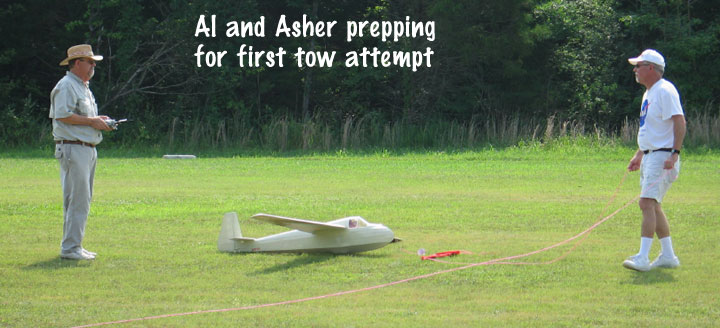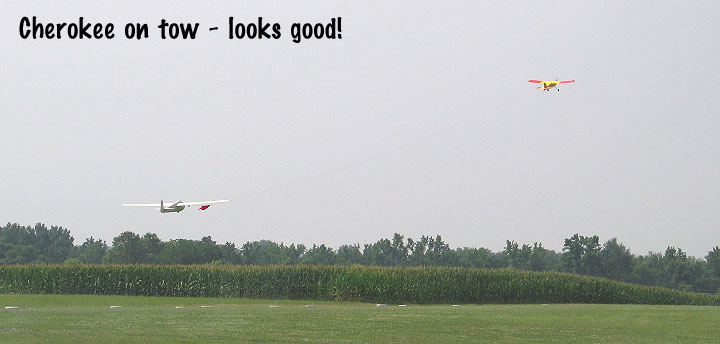
Aerotowing with the Flyin' King - First Attempt
by Al Clark
Well, I finally got to try out the FK on aerotow. She did just fine!
Asher Carmichael, along with his son-in-law Jason Lober, came out to our NARCA flying field this morning at 9:00 AM to help me with the first aerotows. It was hotter than Hades and the humidity was really high, with heat index of 113 degrees, but it was worth it. We had a lot of fun aerotowing with the FK. I want to thank Asher for his help, advice, and flying today, It's great to have someone with experience to show you how it's done! Thanks also to Jason for taking these photos!
I took the FK up first with just the 100' towline attached to see how she handled. Ailerons were more sensitive around neutral with the towline on, but no other differences. The towline helps reduce some of the float on landing, which helps the FK get down quicker between tows.
I had some doubt about the ability of the O.S. 1.20 AX two stroke motor to do a good job on towing, but that proved to be unfounded. Asher had fitted a towline attach point to his old Dodgson Windsong thermal ship, and it was the guinea pig for the first few tows. The FK towed the Windsong easily and we were very high on the first tow before Asher decided to release - the FK was getting hard to see well!
We hooked up my 1/4 scale Cherokee II next, with Asher on the sticks of the Cherokee II. Once again, the FK did a decent job towing her up (Cherokee II weighs 6.5 lbs). Once I found the proper climb angle and speed, the climbout proceeded at a fairly good pace, and we got the Cherokee II up to high altitude in a couple of circles. The only problem I experienced during towing was keeping orientation on one tow, when I got us too far out and couldn't tell which way the FK was turning.
The FK handles differently when a sailplane is on the tow line. The ailerons have much less effect than usual, and turning is best done with a combination of coordinated aileron and rudder input. Once I figured that out, it was easy to make the FK go where I wanted during tow. The elevator proved to have a little too much authority during tow, but that is entirely due to my having a lot of throw and elevator response for normal flying, which is how I set up all my planes to get good acro. A little exponential dialed in took care of that.
The flaps on the FK are really nice for aerotowing. After releasing the sailplane, going to full flaps and idle on the engine allows the FK to be brought down in a very steep spiral, getting her on the runway quickly for the next tow. I wouldn't want to tow without the flaps.
Based upon our experience today, we think the FK should be able to tow sailplanes up to 10 pounds with no problem, using the O.S. 1.20 AX engine.
I should mention the minor mods that I have made to the FK for aerotow:
- O.S. 1.20 AX two stroke engine with Zinger 16x8 wood prop.
- Taller LG from a Great Planes Giant Big Stik ARF to get more prop clearance.
- Four servos on the wing, to get more servo power on the flaps
- 20 oz. fuel tank
- Added a towline attach and release using a 1/4 scale servo to ensure enough power to release the towline in an emergency
- Sheeted the top of the fuselage behind the wing and added diagonal bracing in the bottom rear fuselage bays for more torsional rigidity
- Moved the elevator hinge line forward 1" to get more elevator authority for acro - this is NOT necessary for aerotowing
- Moved the rudder hinge line forward 3/4" to get more rudder authority for acro - this is NOT necessary for aerotowing
My FK, with mods, required about 5 ozs. of tail weight to balance at 30% chord, and all-up is 10.7 lbs.
Bottom line, the FK makes a good low-budget towplane.



<Back to Al in Alabama